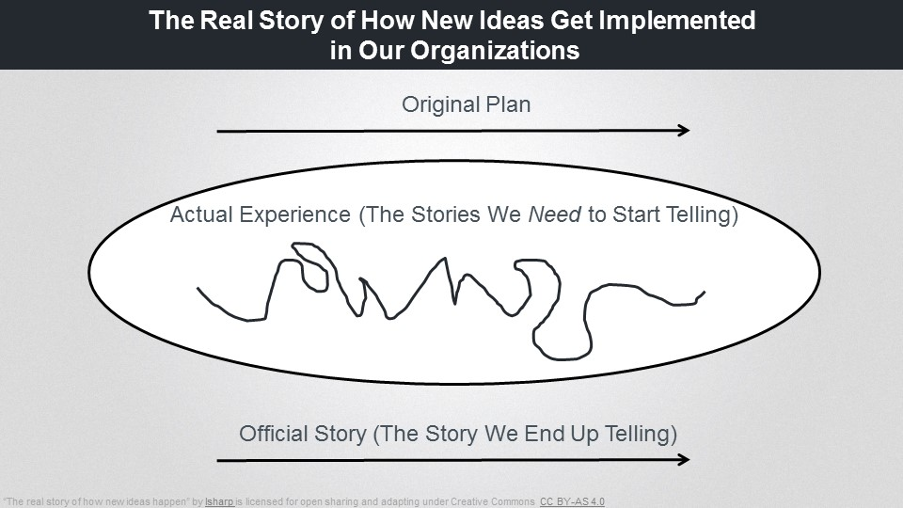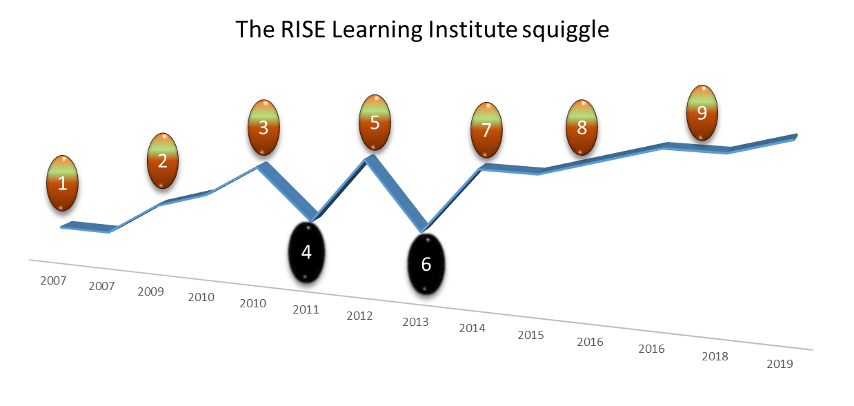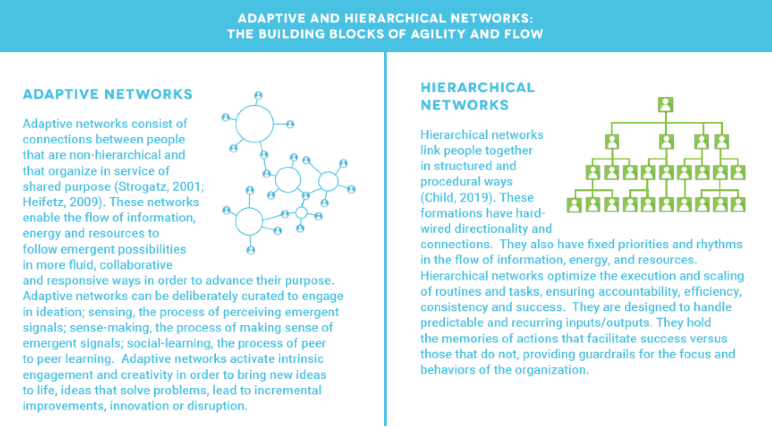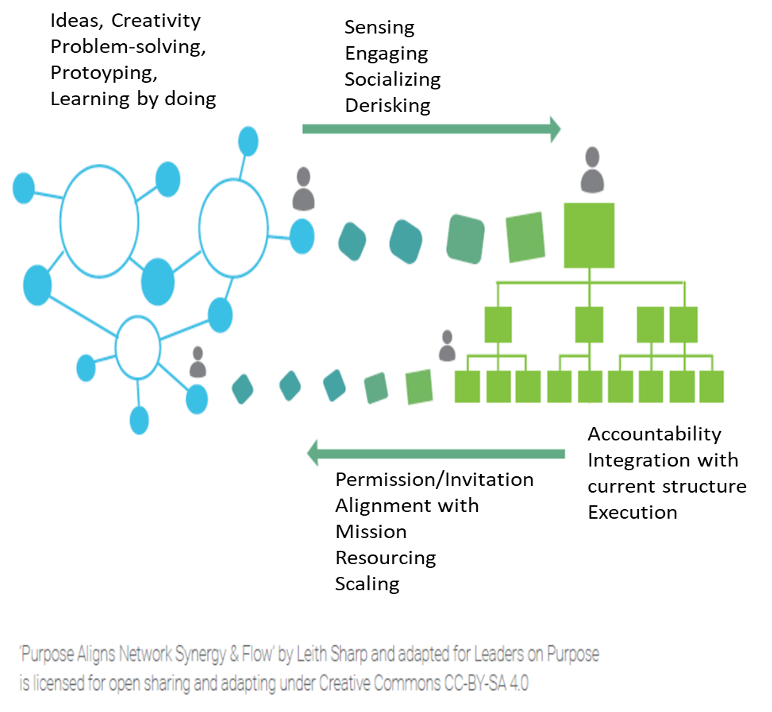6 On the RISE: A Case Study of Institutional Transformation Using Idea Flow as a Change Theory
Gita Bangera, Cheryl Vermilyea, Michael Reese, and Irene Shaver
In the 21st century, a significant number (39%) of all undergraduates start their education at community colleges, and the percentage is even higher for groups historically underserved in higher education (Ginder et al., 2017). Community colleges therefore need to not only develop innovative practices that allow students to succeed but also scale up those innovations to have the greatest impact. In this article, we will share the development of the RISE Learning Institute as a case study in institutional transformation at a community college. We place this case study in the context of the “Idea Flow” concept articulated and curated by Leith Sharp (2019), Director of Executive Education for Sustainability Leadership, Center for Health and the Global Environment at the Harvard Chan School of Public Health. We present our analysis to encourage change agents at other institutions to use the concept of Idea Flow to identify strategies for long term sustainable implementation of their innovative ideas.
1 Theory of Change: Idea Flow
What happens to ideas in an organization? Why do some ideas become absorbed into an institution and some flare up for a while and then quietly disappear?
To understand the trajectories of ideas, Sharp (2019) encourages a process of forensic mapping. In forensic mapping, the individuals responsible for the successful institutionalization or struggling with the demise of a concept, trace the actual path from the original concept to the current stage and unearth all the stages of forward movement and setbacks. Sharp reasons that at the beginning of most projects, there is a well laid-out plan that looks very linear, but when the plan is actually implemented, the path is more of a squiggle (Figure 1a). Success is achieved because individuals use their “unconscious competencies” to tackle challenges. Unfortunately, once success has been achieved, the squiggle story is replaced by the original linear plan in all the reporting. What is the cost or missed opportunity of telling a story of transformation as if it were direct, completely conscious, and safe from failure? The story of exponential improvement and linear change hides a lot of the learning. It does not attribute transformation to the people that actually create it or do justice to the actual nebulous process that change is. Through forensic mapping, the organization can become conscious of the underlying skills and strategies and then apply those to a “forward mapping” process for new ideas so as to increase the chances of their success.
Figure 1: Idea Flow—Real vs Official Story


In analyzing the idea flows from many different organizations, Sharp found that the squiggles in the forensic map of change are caused by interactions, collaborations, synergies, or conflict between people in the organization that have positional power and those that do not. The Adaptive Network (AN) is made up of individuals who may not have positional power but who are aware of the needs of institution and are focused on the idea itself—what it is, why, and how to implement it. The Hierarchical Network, (HN, traditionally known as management) performs the critical role of integrating the new idea into everything that already exists. It is important to focus on the interactions between these two networks in an organization to see how they propel change, redirect it, constrain it, normalize it or amplify the implementation of an idea. These two networks of people in an organization have different strategies and ways that they contribute to a process of institutional change. Ideas and projects get successfully institutionalized when there is a constant flow of information and support between the two networks. The AN senses needs, engages the community, pilots, de-risks, and socializes the idea while the HN provides permission, invitation, alignment with mission, resources, sponsorship, and assimilation into the system and scaling (Figure 2) (Sharp, 2019).
Figure 2: The Two Networks Concepts


In the context of Idea Flow, we now present the development of the RISE Learning Institute first as a linear story and then as an Idea flow story with the squiggles.
2 RISE Learning Institute—The Linear Story
At our institution, we have engaged in a thirteen-year process of institutional change, with the development of the RISE Learning Institute starting from a few undergraduate research courses begun with National Science Foundation (NSF) funding. The program was disseminated throughout the state of Washington with a community of practice involving faculty from 24 community colleges.
In 2015, the college created the RISE Learning Institute. The Institute is led by a Dean, a new position created by the college, has multiple full-time positions, and includes the Center for Career Connection as well as the Neurodiversity Navigators. RISE also has two impactful student learning spaces—a state of the art multi-use laboratory space used for research, experiential learning courses, and student-run maker space, as well as a Collaboratory space for making the creative process explicit. From 2015–2019, RISE has built three Faculty Learning Communities (FLCs) in undergraduate research, service learning, and project-based learning, and engaged 6,184 students in transformative learning including service learning, project-based learning, undergraduate research, maker space activities, minority- and disability-related learning communities, and career development. RISE has increased student engagement in transformative learning by 42% from 2016–2019.
The RISE Learning Institute brings High Impact practices (Kuh, 2008) to scale across all disciplines. These practices include internships, service learning, undergraduate research, project-based learning, career exploration, and learning communities. Transformative learning requires students to integrate, synthesize, and make meaning; address authentic, complex, real-world issues; reflect on their own experiences and learning; and identify, articulate, and apply their strengths. The most impactful transformative learning experiences include strengths-based approaches and career development. Undergraduates who engaged in these experiences were markedly more likely than their peers to feel that they were engaged and thriving in life and the workplace after graduation (Ray & Marken, 2014; Table 1). Yet, most students at community colleges do not experience these impactful learning modalities because of the barriers to innovation that exist in community colleges and other institutions of higher education.
RISE also helps to combat what could be termed as the “firefly effect.” Individual faculty follow their passion to develop undergraduate research, service learning or other course materials, or even entire courses. However, when the faculty member leaves or loses steam due to burn out, the program ends and does not scale up to the department or institutional level. By creating a college-wide Institute focused on supporting faculty through the development and implementation of these experiences in the classroom, RISE allows true scaling of these transformative learning experiences.
RISE is also a vehicle to increase educational equity. While it is important to bring transformative learning to students, incorporating them into the classroom is key from an equity perspective (Bangera & Brownell, 2014). Students of color, first-generation students, and those from lower socio-economic status may not have the bandwidth, financial resources, and/or time to take advantage of optional opportunities outside of their regular coursework. They may also not have the cultural capital to know the importance of these experiences or the confidence to apply for the opportunity. Incorporating transformative learning into regular courses also ensures sustainability of these programs by ensuring that these activities are built into the normal revenue generation process (i.e. tuition) for the institution. We are currently building these transformative learning activities into the curriculum of high enrolled courses (reaching 300–400 or more students) to democratize access and maximize impact in a financially sustainable model.
| The odds of being engaged at work are: | |||
| 2.6x | Higher if … [College] prepared me well for life outside of college. | 2.4x | Higher if … [College] passionate about the long-term success of its students. |
| 2.2x | Higher if … I had a mentor who encouraged me to pursue my goals and dreams. | 2.0x | Higher if … I had at least one professor at [College] who made me excited about learning. |
| 1.9x | Higher if … My professors at [College] cared about me as a person. | 2.3x | Higher if … graduates experience all three. |
| 2.0x | Higher if … I had an internship or job that allowed me to apply what I was learning in the classroom. | 1.8x | Higher if … I was extremely active in extracurricular activities and organizations while attending [College]. |
| 1.8x | Higher if … I worked on a project that took a semester or more to complete. | 2.4x | Higher if … graduates experience all three. |
| The odds of thriving in all areas of well-being are: | |||
| 4.6x | Higher if … Engaged at work. | 2.0x | Higher if … Emotionally attached to school. |
| 2.5x | Higher if … [College] prepared me well for life outside of college. | 1.9x | Higher if … [College] passionate about the long-term success of its students. |
| 1.7x | Higher if … I had a mentor who encouraged me to pursue my goals and dreams. | 1.7x | Higher if … My professors at [College] cared about me as a person. |
| 1.5x | Higher if … I had at least one professor at [College] who made me excited about learning. | 1.9x | Higher if … graduates experience all three. |
| 1.5x | Higher if … I had an internship or job that allowed me to apply what I was learning in the classroom. | 1.4x | Higher if … I was extremely active in extracurricular activities and organizations while attending [College]. |
| 1.1x | Higher if … I worked on a project that took a semester or more to complete. | 1.3x | Higher if … graduates experience all three. |
3 RISE Learning Institute—Idea Flow Story
Figure 2b shows the real story of the RISE Learning Institute—our squiggle. Each number below describes the circumstances of the steps in the squiggle image in Figure 2b. Upward movements were times when the idea grew and advanced, and downward movements show the backward steps in the process.
- The AN sensed the need for introducing undergraduate research experiences into the curriculum and proposed a project called ComGen. By seeking external NSF funding for the ComGen project, the AN de-risked the process by piloting pedagogical innovation. The HN provided support for grant development and for purchasing required equipment.
- The AN used grant funds to develop faculty capacity to incorporate the innovative pedagogical tools into courses. This also led to the development of an applied baccalaureate degree that contributed to the revenue of the college, allowing for long-term financial sustainability of the innovation. The HN provided resources in the form of dedicated research lab space to support the development of the program. Additional NSF funding allowed development of a ComGen community of practice that included faculty from Bellevue College and from 22 other community colleges in the state.
- A possibility for building a collaborative program encompassing additional disciplines emerged with the potential development of a larger multi-disciplinary laboratory space.
- A change at the mid-level leadership caused a disruption in the collaboration between HN and AN, and the project was shelved
- A new project for fundraising for the expanded laboratory was started.
- Changes in the administration again caused disruption of the collaboration between the AN and the HN, resulting in the project being shelved.
- Developing stronger relationships with the HN, the AN was able to show a need for development of a new expanded structure, including a Dean position, and combining career exploration, service learning, and experiential learning along with undergraduate research to form the RISE Learning Institute. (There were some squiggles within this story as well that we have not described.)
- Initial work within RISE showed impact and allowed the AN to request and obtain funding for key personnel.
- The HN and the AN worked collaboratively to bring High Impact Practices to scale by implementing the Provost award for Innovation. The award provides funding for faculty teams incorporating high impact practices into courses with 300–400 or more students per term.
Comparing the straight line and idea flow story, it is apparent that the idea and work began far before 2015, when RISE Learning Institute as a program was created. It is also clear that the plan was constantly rearticulated, gained complexity and better form, and became better aligned with the institutions goals until it was fully incorporated. The dips in the squiggle were caused by experiencing a constraint or misalignment between the HN and AN, but there are some durable levers or strategies that seemed to change things and get us back on track.
Lessons learned from our squiggle
- Almost all institutions, especially community colleges, run on tight budgets, and while there may be support for innovation, there may be financial constraints that the HN faces. By seeking external funding for the piloting of the project and demonstrating success, the AN got commitment for future funding from the HN. Similarly, it was helpful to move the innovation into courses or other normal functions of the institution to allow the innovations to become revenue neutral or revenue generating.
- It is important to bring innovation into existing structures that are directly accessible to the population you want to serve and can be stepping stones to scaling up innovation. For example, we used courses as the primary innovation space, as they have the highest access to all student populations and are already part of the student pathway. Faculty control that course space and can innovate there with a high degree of autonomy. More courses with high-impact practices results in better education for more students and produces evidence of success in a short time frame (i.e., over the period of a course).
- It is helpful for the AN and HN members to develop strong trust relationships and take advantage of opportunities at appropriate times. In our case, the construction of a new building provided an opportunity for a dedicated research laboratory. Due to the existing trust and relationship, the HN invited us, the AN, to take advantage of this opportunity.
- As changes happen within the AN and the HN, both networks can be proactive in establishing and re-establishing relationships with leaders to ensure continuity of the flow of communication. If a new administrator or faculty or staff leader joins the institution, it is helpful for both networks to engage and invite them to be an advocate for their idea. This is the critical lesson learned from steps 4 and 6 in the squiggle.
- The HN can influence change by supporting the most influential resource in the institution. In our case, this is the faculty and staff, who have the primary institutional relationship with and create the learning experiences for our students. By the same token, faculty and staff need to participate fully as a key part of the AN and institution by developing relationships with the HN, and sensing, responding to, socializing, and de-risking ideas (Figure 2b).
- Both the AN and the HN are most effective when they work at multiple places at the same time and are patient. The AN can provide peer-to-peer influence/socializing, while the HN can provide strategic support where needed. In our case, the HN provided funding and space and incorporated the concepts of transformative learning into the institution’s strategic plan and promotion criteria for faculty. The AN participated in open curriculum sharing, FLCs, and communities of practice to share best practices and support each other in bringing these new, high-impact practices into the classroom.
- Both networks can work together to institutionalize the innovative practices by building on successful programs. Once the FLC for service learning was established, the barriers for developing the subsequent FLCs (for project-based learning and research) were much lower. Rather than having to reinvent the wheel, we were able to take the successful approaches, lessons learned, and assessment instruments developed and adapt them from one domain to another. Similarly, our experience with the ComGen community of practice prepared us to support course-based undergraduate research across multiple disciplines. Our composite structure thus allowed us to harness synergies by reducing the time cost of innovation and by “flattening the learning curve” of deploying innovation in new domains.
4 Conclusion
In conclusion, we plan to apply the lessons learned from the Idea Flow analysis to develop and sustain future innovations on our campus. We also found that what appeared to be a significant setback provided space for the idea to evolve into a more impactful project. We encourage other institutions to consider forensic mappings of both successful and unsuccessful implementation of ideas, to uncover the squiggle, and apply the lessons learned in a forward mapping process to ensure sustainability of innovative and impactful initiatives.
5 About the Authors
M. Gita Bangera is the Dean of the RISE Learning Institute at Bellevue College.
Cheryl Vermilyea is the founder of the Center for Career Connections at Bellevue College and the Minority Science and Engineering Program at the University of Washington.
Michael Reese is the Director of Program Development in the RISE Learning Institute at Bellevue College.
Irene Shaver is a Program Manager in RISE at Bellevue College.
6 References
Bangera, G., & Brownell, S.E. (2014). Course-based undergraduate research experiences can make scientific research more inclusive. CBE—Life Sciences Education, 13(4), 602–606. https://doi.org/10.1187/cbe.14-06-0099
Ginder, S.A., Kelly-Reid, J.E., & Mann, F.B. (2017). Postsecondary institutions and cost of attendance in 2016–17; Degrees and other awards conferred, 2015–16; and 12-month enrollment, 2015–16: First look (provisional cata) (NCES 2017-075rev). U.S. Department of Education. https://nces.ed.gov/pubs2017/2017075rev.pdf
Kuh, G. D. (2008). High-impact educational practices: What they are, who has access to them, and why they matter. Association of American Colleges and Universities.
Ray, J. & Markam, S. (2014). Life in college matters for life after college. Gallup. https://news.gallup.com/poll/168848/life-college-matters-life-college.aspx
Sharp, L. (2019). Leading organizational agility and flow to deliver on corporate purpose in purpose-driven leadership for the 21st century: How corporate purpose is fundamental to reimagining capitalism. 2017–2019 Global multi-year CEO study (C. Gyori, T. Kazakova, B. Gyori, Eds.). Leaders on Purpose.

